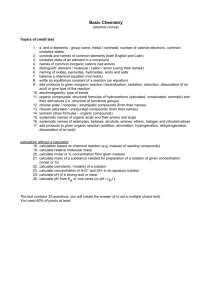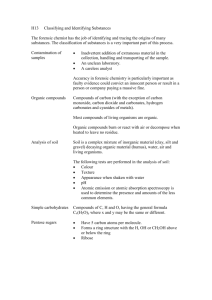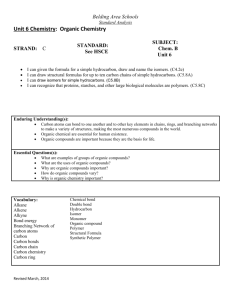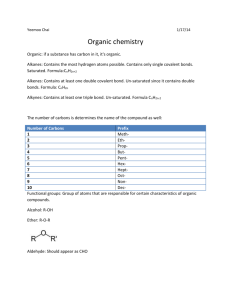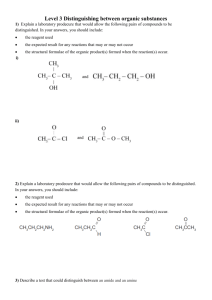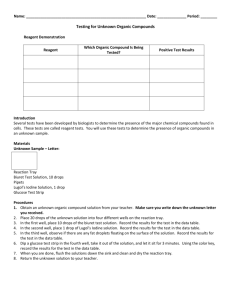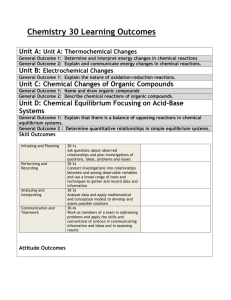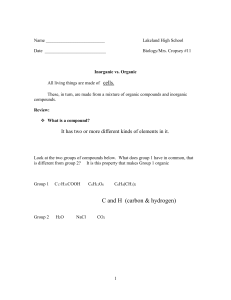Organic Compounds C11-5-01
advertisement
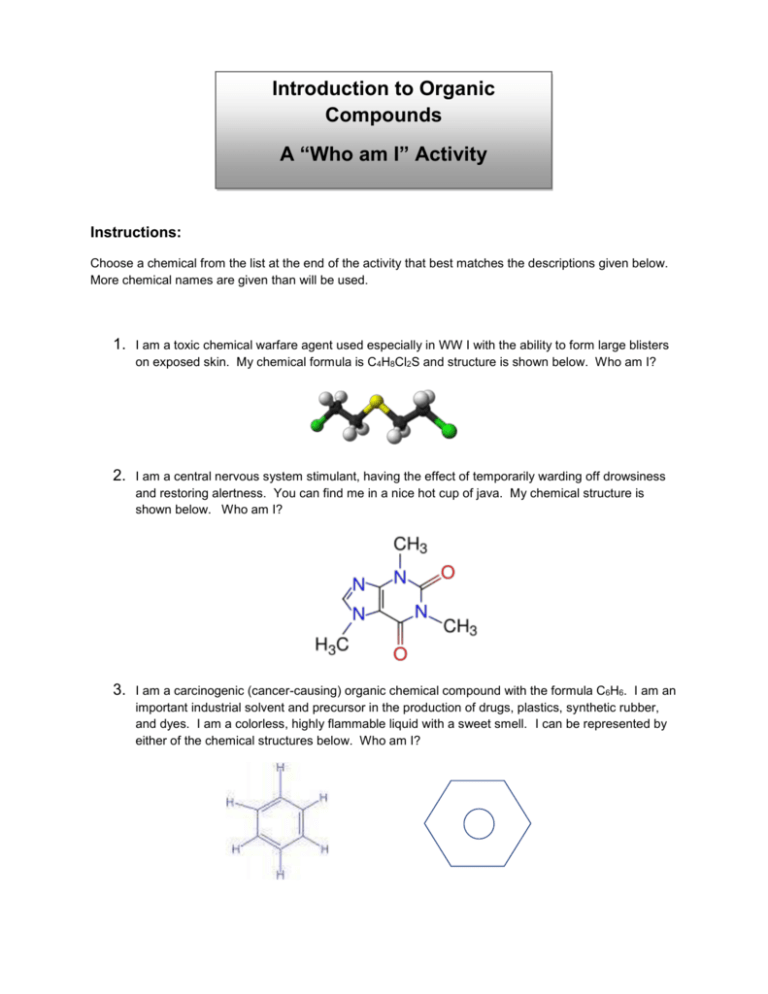
Introduction to Organic Compounds A “Who am I” Activity Instructions: Choose a chemical from the list at the end of the activity that best matches the descriptions given below. More chemical names are given than will be used. 1. I am a toxic chemical warfare agent used especially in WW I with the ability to form large blisters on exposed skin. My chemical formula is C4H8Cl2S and structure is shown below. Who am I? 2. I am a central nervous system stimulant, having the effect of temporarily warding off drowsiness and restoring alertness. You can find me in a nice hot cup of java. My chemical structure is shown below. Who am I? 3. I am a carcinogenic (cancer-causing) organic chemical compound with the formula C6H6. I am an important industrial solvent and precursor in the production of drugs, plastics, synthetic rubber, and dyes. I am a colorless, highly flammable liquid with a sweet smell. I can be represented by either of the chemical structures below. Who am I? 4. I am a major ingredient in Tylenol™. I am used for the relief of fever, headaches, and other minor aches and pains. My chemical structure is shown below. Who am I? 5. I am an alkaloid found predominantly in tobacco and coca plants. In low concentrations, I act as a stimulant in mammals. I am one of the main factors responsible for the dependence-forming properties of tobacco smoking. My chemical structure is shown below. Who am I? 6. I am a highly flammable, colorless, odorless, easily liquefied gas. I can be found in Bic™ lighters. I have a low boiling point so when the lighter is flicked, I vaporize and ignite easily. My combustion reaction with oxygen produces CO2 and H2O. I have the chemical formula C4H10 and my chemical structure is shown below. Who am I? 7. I am the intoxicating ingredient in alcoholic beverages. I have had widespread use as a solvent for substances intended for human contact or consumption, including scents, flavorings, colorings, and medicines. I am produced through the hydration of ethylene, and biologically, by fermenting sugars with yeast. I have the chemical formula C2H5OH and my chemical structure is shown below. Who am I? 8. I am an organophosphate insecticide of relatively low human toxicity. I poison and kill mosquitoes and my use has been controversial. I am also used as a treatment for head lice, body lice, and scabies. My chemical structure is shown below. Who am I? 9. I have a sour taste and pungent smell. I am corrosive, and my vapor causes irritation to the eyes, a dry and burning nose, sore throat and congestion to the lungs. Despite this, many people like to dilute me and add me to French fries. My chemical formula is CH3COOH and my structure is shown below. Who am I? 10. I am produced by the catalytic oxidation of methanol. I am used in embalming to disinfect and temporarily preserve human remains. I am also useful as a disinfectant, as I kill most bacteria and fungi. I am also used as a preservative in vaccinations. I can be represented by the chemical structures shown below. Who am I? 11. I am a semi-synthetic psychedelic drug. I am used (illegally) mainly as a recreational drug. People who use me may experience physical symptoms such as uterine contractions, hypothermia, fever, elevated levels of blood sugar, goose bumps, increase of heart rate, jaw clenching, perspiration, pupil-dilation, saliva production, mucus production, sleeplessness, paresthesia, euphoria, hyperreflexia, tremors and synesthesia. Also, most users report numbness, weakness, trembling, and nausea. I can be represented by the chemical structures shown below. Who am I? 12. I am a monosaccharide, and I taste nice and sweet. The living cell uses me as a source of energy. I am one of the main products of photosynthesis. My chemical structure is C 6H12O6 and is shown below. Who am I? 13. I was prescribed during the late 1950s to pregnant women, as an antiemetic to combat morning sickness and as an aid to help them sleep. It came with catastrophic results for the children of women who had taken me since approximately 10,000 children were born with severe malformations as a result. I am currently used for my anti-inflammatory effects to treat a painful skin condition associated with leprosy. My chemical structure is shown below. Who am I? 14. I am a relatively potent greenhouse gas with a high global warming potential. I am the simplest alkane and the principal component of natural gas. I am colorless and odorless, although I am often mixed with an odorant as a safety measure. I am not toxic; however, I am highly flammable and may form explosive mixtures with air. I can be represented by the chemical structures shown below. Who am I? 15. I am referred to as the "fight or flight" hormone, and I play a central role in the short-term stress reaction. I am released from the adrenal glands when danger threatens or in an emergency. When secreted into the bloodstream, I rapidly prepare the body for action in emergency situations. I boost the supply of oxygen and glucose to the brain and muscles, while suppressing other non-emergency bodily processes (digestion in particular). I am also used in EpiPens. I can be represented by the chemical structures shown below. Who am I? Summary: So what do all of the substances you stated as answers for #1-15 have in common? They are all organic compounds. Organic compounds are a class of chemical compounds in which one or more atoms of carbon are covalently linked to atoms of other elements, most commonly hydrogen, oxygen, or nitrogen. For example, glucose is organic, since its molecular formula is C6H12O6. Carbon dioxide (CO2) is inorganic since it does not contain hydrogen. They form the basis of, or are important constituents of many products (paints, plastics, food, explosives, drugs, petrochemicals, to name but a few) and (apart from a very few exceptions) they form the basis of all earthly life processes. Word List: Butane Ethanol Ascorbic Acid Epinephrine (Adrenaline) Formaldehyde LSD ASA (Acetylsalicylic acid) Caffeine Methane Malathion Dioxin Glucose Thalidomide Octane Mustard Gas Benzene Acetic Acid (Vinegar) Acetaminophen Nicotine Isopropyl alcohol Key: 1. Mustard Gas 2. Caffeine 3. Benzene 4. Acetaminophen 5. Nicotine 6. Butane 7. Ethanol 8. Malathion 9. Acetic Acid (Vinegar) 10. Formaldehyde 11. LSD 12. Glucose 13. Thalidomide 14. Methane 15. Epinephrine (Adrenaline)

